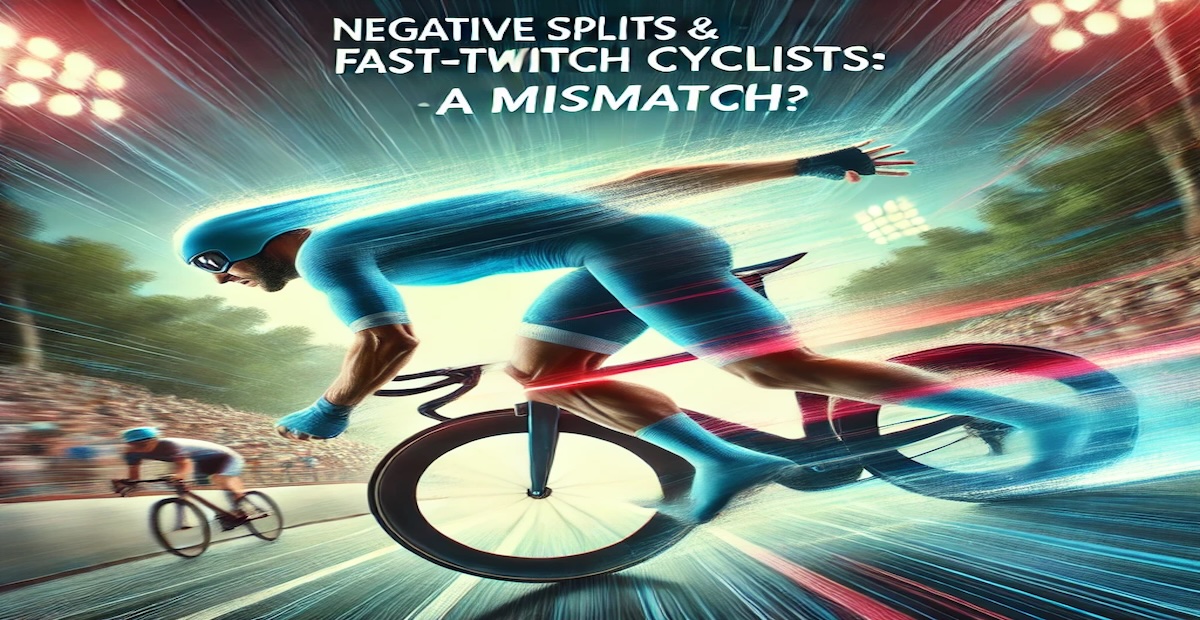Why Negative Splits Don’t Work for Fast-Twitch Cyclists: The Science Behind Pacing Strategies
Why Negative Splits Work for Some but Not for Others
Negative splits—the strategy of finishing a race or workout faster than you started—are widely recommended in endurance sports. However, if you’re a fast-twitch or explosively dominant cyclist, this approach may not work for you. Why? Because your physiology may not allow for a strong ramp-up in power late in the ride. Instead, a front-loaded or steady pacing strategy may be more effective. Let’s dive into the science behind this.
Fast-Twitch vs. Slow-Twitch Cyclists: The Key Differences
1. Muscle Fiber Composition & Power Output
- Fast-twitch dominant cyclists (Type II fibers) generate high peak power but fatigue faster. Their power-duration curve is steeper, meaning they thrive on short bursts but struggle with sustained efforts.
- Slow-twitch dominant cyclists (Type I fibers) have a flatter power curve, making them well-suited for endurance events where negative splits are most effective.
2. Energy System Utilization
- Fast-twitch cyclists rely more on anaerobic energy systems, such as phosphocreatine and anaerobic glycolysis, which provide powerful but short-lived bursts of energy.
- Slow-twitch cyclists use aerobic metabolism, which is more efficient for prolonged efforts and allows for a gradual increase in power over time.
Why Negative Splits May Not Work for Fast-Twitch Cyclists
1. Underutilization of Peak Power Early
Fast-twitch cyclists depend on their ability to generate high power from the start. If they hold back too much, they miss the opportunity to use their anaerobic stores effectively, leading to a lower total output by the end of the ride.
2. Greater Fatigue Accumulation
Since fast-twitch fibers fatigue quickly, a late-stage surge in power is difficult. By the time they reach the second half of a ride, their energy systems are already taxed, making it hard to ramp up the effort.
3. Limited Aerobic Efficiency for Pacing Adjustments
Unlike slow-twitch cyclists, fast-twitch athletes don’t have the same aerobic efficiency to progressively increase output over time. Their best strategy may involve pacing more aggressively from the beginning and holding on.
Scientific Evidence Supporting This Theory
Several studies highlight why negative splits may not be ideal for fast-twitch cyclists:
- Ronnestad et al. (2011) found that cyclists with higher proportions of fast-twitch fibers performed better with a strong start rather than a conservative pacing approach.
- Spragg et al. (2021) showed that anaerobically dominant cyclists experience sharper declines in performance when adopting endurance-based pacing strategies.
- Abbiss & Laursen (2008) reviewed pacing strategies in endurance sports and found that negative splits are most effective for slow-twitch athletes with strong aerobic endurance.
The Best Pacing Strategy for Fast-Twitch Cyclists
Instead of a strict negative split, a front-loaded or even-split strategy may be more effective:
✅ Start strong but controlled – Use early anaerobic energy to establish a high baseline without overexerting.
✅ Maintain steady effort mid-race – Avoid excessive lactate accumulation while keeping power high.
✅ Accept slight fade toward the end – Rather than expecting a second-half power surge, focus on sustaining as much of the initial effort as possible.
Final Thoughts: Should You Ditch Negative Splits?
If you’re a fast-twitch dominant cyclist, negative splits may not be the best strategy. Your ability to generate power is front-loaded, and once fatigue sets in, it’s harder to ramp up. Instead, a strong but sustainable start with steady pacing will likely yield better results.








